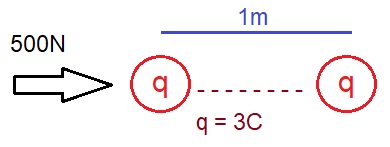Key Idea
Electrical Potential Energy - Voltage
As you know, gravity makes a pen fall when you let it go and we can calculate the pen's potential energy at any point in its fall. The attraction of two opposite
charges can be compared to gravity, and calculations of Electrical Potential Energy can be made.
Energy is required to separate positive and negative charges and this charge separation produces an electrical potential difference that
can be used to drive current in circuits.
For example, the different charges (voltages) in a battery 'pull' electrons from the negative end to the positive end.

voltage (Electrical Potential) is defined as the Force required, per unit of charge, to move a charge a distance.
 In an electrical circuit voltage is measured using a voltmeter.
In an electrical circuit voltage is measured using a voltmeter.
Consider the situation of a charged ball sitting between two plates of different voltages

If the charge is positive and the top plate +2000V as an example, we can calculate the Force required to move the ball.
Note; if both plate and ball are positive, they will repel each other so it will take energy to move them together.
Warning
Before we jump in, consider the comparison with Potential Energy. If we only move a pen up 2 metres, when the balcony is 4m high, then
we have only changed the potential energy by half the balcony height.
If we only move the charged ball half way between the two plates
then we only change its Electrical Potential by half the difference between the plates.
Lets add the numbers
q (Charge of ball) = 20C
V (voltage difference), Between the two plates = 2000V, therefore the change in Electrical Potential or Voltage by moving it 0.5m is = 1000V
d (the distance we wish to move the ball) = 0.5m
Rearrange the equation
F = qV/d
= 20 x 1000 / 0.5
= 40000N
Consider a different example

If it took 500N to move a charge of 3C 1m, then the increase in Voltage (as given by the equation) is 167V.
Videos
SeeBlocks, What is voltage
ElectroBOOM, Definition of Voltage
PhysicsHigh, What is Voltage
|



